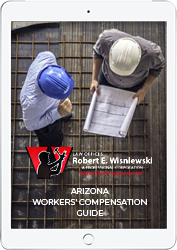Our Arizona workers’ compensation attorneys can tell you how much compensation is owed for a shoulder injury on the job
Unless you’re a professional baseball player, most people don’t worry about hurting their shoulder while on the job—until it happens to them.
Your shoulder is a marvel of engineering, capable of throwing a baseball at over 100 miles per hour and making nearly 230-degree circles backward and forwards. However, this complex multi-directional joint isn’t invincible. Certain movements can place stress on the shoulder, resulting in a painful injury that makes simple tasks like lifting your arm or carrying a box an extremely painful endeavor.
Professional athletes and workers in manufacturing, agriculture, construction, health care and other professions across Arizona are particularly vulnerable to painful shoulder injuries. These injuries can occur as a result of repetitive movements endured over several years, or they can happen because of a sudden and severe accident in the workplace.
Common shoulder injuries include:
- Tendonitis
- Fractures
- Arthritis
- Torn rotator cuffs
- Sprains and strains
- Dislocations
- Separations
- Bursitis
- Acromioclavicular joint syndrome
- Frozen shoulder syndrome (adhesive capsulitis)
- Fractures
- Arthritis
- Impingement syndrome
If you’ve hurt your shoulder while on the job, it’s time to seek professional legal advice and representation. A skilled work injury lawyer can advise you of your rights and fight to see that you’re compensated for your injuries.
Without professional representation, many injured workers fail to receive the justice and compensation they deserve.
Injured workers don’t have to shoulder the responsibility of preventing workplace injuries on their own. Employers also bear some of the responsibility.
Our experienced work injury attorneys can help you understand your legal options and determine how much compensation you’re owed. Schedule your free consultation today.
Shoulder injury risk factors
When it comes to shoulder injuries, there are many possible risk factors—some of which you can’t control. For instance, your gender, weight, age, and other underlying medical disorders (such as arthritis, fibromyalgia, multiple sclerosis and diabetes) can affect your risk of a shoulder injury. Some research even suggests that seemingly unrelated things like smoking and psychological factors such as depression and anxiety can increase your risk of shoulder pain.
There are factors in the workplace that can increase your risk of a shoulder injury, including:
- Physical tasks that lead to overexertion, like heavy lifting, pushing, pulling, holding or carrying
- Working above shoulder height
- Repetitive motion work
- Vibrations
- Working in an awkward posture
Many of these risk factors can be avoided or minimized by using proper ergonomics and safety equipment.
Employee Training: The Surprising Benefits for Employers & Workers
Learn why a lack of training is bad for employers and employees alike.
Shoulder injury statistics
According to research, shoulder pain affects approximately 18 to 26% of adults at any point in time, making it one of the most common regional pain syndromes. In fact, rotator cuff and other shoulder injuries are some of the most common occupational musculoskeletal problems that arise at home and in the workplace.
Once a shoulder is injured, recovery can be painfully slow, eliminating or reducing a worker’s ability to perform. According to the U.S. Bureau of Labor Statistics (BLS), in 2014, shoulder injuries caused workers to miss an average of 26 days of work, more than any other body part.
Statistics also show that certain industries have higher rates of shoulder injuries than others. For example, natural resources, construction, and maintenance (NRCM) occupations had higher incidence rates for shoulder injuries than all other occupations.
Is my shoulder injury eligible for Arizona workers’ compensation?
Much like neck and back injuries, to qualify for workers’ compensation benefits for a work-related shoulder injury, one of the following statements must be true:
- You sustained an injury that was caused by an accident or specific event in the workplace.
- Your injury manifested after you experienced strain from repetitive job-related motion over a period of time.
- Your current employment aggravated a pre-existing injury or condition.
Please note that under Arizona workers’ compensation law, injured workers only have 1 year from the date of injury to file a claim with the Industrial Commission of Arizona. The worker must also notify their employer as soon as possible after a work-related injury has occurred.
An attorney can assist in this process by ensuring that the severity of your injury isn’t overlooked and that you don’t miss any important deadlines that could prevent you from recovering compensation.
What kinds of medical care are covered under workers’ comp?
Fortunately, all necessary medical treatment, including surgery, medication and rehabilitation, is covered under workers’ comp in Arizona after a shoulder injury.
A typical worker often first seeks out conservative medical care, such as injections and therapy, to see if the injury can be resolved without surgery. Unfortunately, many times, the worker must undergo surgery on their shoulder and, ultimately, physical therapy.
While in the process of recuperating from conservative care or surgery, the worker is generally put in a status known as “temporary total disability” (TTD) or “temporary partial disability” (TPD). If they’re unable to work at all, they are placed in TTD and receive two-thirds of their average monthly wage.
If they’re in a partial work ability designation, such as light-duty, then their earnings are deducted from TTD payments, so they would get a check from the insurance company and their employer.
Returning to Work After a Workplace Injury in Arizona
When can Arizona workers resume light-duty work after a job-related injury?
Typically, shoulder injuries are so severe that there aren’t many opportunities for light-duty work, or the employer doesn’t have opportunities for light-duty if the injured worker is in a heavy labor trade.
In such cases, the worker will ultimately continue recuperation until they reach a point known as “maximum medical improvement,” or MMI. This is the point when the worker isn’t expected to get any better or any worse, even with continued treatment.
When MMI is reached, the doctor rates the injured worker based on the American Medical Association’s (AMA’s) guidelines for permanent disability. These guidelines help the doctor assign a numerical rating to the injured worker’s shoulder and define what the worker can and cannot do in terms of work—or, in other words, their work restrictions.
Even if they’re able to work, what can the injured worker do with their injured shoulder in terms of pushing, pulling, lifting overhead, and weight limitations?
This is an important question, as are the frequently asked questions below.
What types of work restrictions are common for shoulder injuries?
Work restrictions for a shoulder injury can be quite specific to ensure proper healing and prevent further damage. Here are some common ones:
- Limit lifting. This might include restricting the amount of weight a worker can lift, often no more than 5 to 10 pounds, to avoid exacerbating the injury.
- Avoid overhead work. Workers might be restricted from performing tasks that require reaching above shoulder level, as these movements can stress the shoulder joint and muscles.
- Reduce work hours or modify schedules. Allowing for shorter work days or breaks to rest the shoulder can help manage the pain and fatigue associated with recovery.
- Use ergonomic aids. This might involve providing tools or equipment that reduce the strain on the shoulder, such as adjustable-height workstations or ergonomic tools.
- Avoid certain movements. These restrictions might include no pushing, pulling, or twisting motions that involve the injured shoulder to prevent undue stress.
These restrictions are designed to accommodate an employee’s recovery needs while maintaining as much of their work capability as possible.
How much should I settle for a shoulder injury?
An appropriate and fair shoulder injury settlement varies greatly depending on the severity of the injury and the nature of a person’s work. For example, a fair settlement for a severe rotator cuff tear might be high if the injured worker is young and works as a delivery driver, whereas an appropriate settlement for the same injury might be lower if the injured employee is about to retire and works at a desk job.
So, what’s the average workers’ comp settlement for shoulder injuries?
According to the National Safety Council, between 2021 and 2022, workers with an injured shoulder received about $25,821 in medical benefits and $24,017 in lost wage benefits, for an average total settlement of $49,838.
Since each case is different depending on the type of injury and unique circumstances of the claim, it’s important you speak with a knowledgeable work injury attorney to help you determine how much you should settle for.
How much will I get for a shoulder injury?
Many shoulder injury settlements approach $100,000 or more, but some settle for far less. While we can’t calculate precisely how much your case is worth without knowing more details, we can tell you that insurance companies regularly undervalue shoulder injury cases. For this reason, you should never accept a settlement offer until you’ve spoken to an experienced attorney.
Should You Settle or Fight Your Arizona Workers’ Compensation Claim?
Pros and cons of settling or fighting your workers’ comp case in court.
What shoulder injuries require surgery?
While some shoulder injuries heal with a little rest, physical therapy and other nonsurgical treatments, others require intensive surgery. Surgery should always be a last resort, but some injuries will worsen over time without a quick procedure.
If nonsurgical intervention doesn’t work, surgery may be required for the following shoulder injuries:
- Traumatic shoulder injuries (from a slip-and-fall accident or car accident)
- Partial and full rotator cuff tears (impingement syndrome)
- SLAP (superior labrum anterior and posterior) tear
- Bicipital tendinitis
- Repeated dislocation
- Frozen shoulder
- Distal clavicle osteolysis
- Severely displaced fractures (acromioclavicular joint separation)
- Fractured head of the arm bone (proximal humerus fracture)
- Severe rheumatoid arthritis (if experiencing pain and limited mobility)
Workers’ comp for a shoulder injury that requires surgery
If a shoulder injury doesn’t respond to conservative, nonsurgical treatments, it might be necessary to undergo surgery. These procedures can range from minimally invasive operations to open surgeries, and the recovery times vary.
Fortunately, workers’ comp will pay for all necessary surgeries, hospitalizations and rehabilitation related to a shoulder injury at work.
Common types of shoulder surgeries covered by workers’ comp include:
- Arthroscopy. This is a minimally invasive surgical procedure used to diagnose and treat joint issues within the shoulder. It involves making small incisions to insert a tiny camera and instruments, which allows the surgeon to view and repair the joint tissues. Workers involved in repetitive overhead activities, such as painters or construction workers, may require arthroscopic shoulder injury surgery due to the wear and tear on their shoulder joints from continuous strain and movement.
- Rotator cuff repair. This is a surgery used to fix tears in the rotator cuff, which is a group of muscles and tendons that stabilize the shoulder joint. This procedure can be performed through open surgery, minimally invasive arthroscopy, or a combination of both, depending on the severity of the tear. Workers who engage in activities requiring repetitive lifting or overhead motions, such as warehouse workers or athletes like baseball pitchers, are more likely to need this surgery due to the high stress placed on their shoulder tendons.
- SLAP repair. This is a surgical procedure used to fix a specific type of shoulder injury called a SLAP (superior labrum anterior and posterior) tear, where the top part of the labrum, a ring of cartilage that surrounds the shoulder socket, is damaged. This surgery is typically conducted via arthroscopy to reattach the torn labrum to the bone of the shoulder socket. Workers who experience acute shoulder trauma or engage in repetitive overhead activities, such as painters, are more susceptible to this type of injury, potentially leading to the need for SLAP repair.
- Bankart repair. This is a surgical procedure aimed at fixing a Bankart lesion, which is an injury to the anterior (front) part of the labrum of the shoulder joint, typically resulting from a dislocation. This surgery is often performed arthroscopically and involves reattaching the torn labrum to the shoulder socket to restore stability to the joint. Workers who experience shoulder dislocations from falls or direct impacts, such as roofers and law enforcement, may require this type of surgery to prevent recurrent shoulder instability.
- Shoulder fracture repair. This is a surgical procedure used to treat fractures of the shoulder components, such as the clavicle, humerus, or scapula. This surgery may involve the use of plates, screws, or rods to hold the broken bones in place while they heal. Workers who experience direct impacts or falls, including roofers and first responders, are prone to such injuries.
- Shoulder replacement surgery (or partial replacement, known as a hemiarthroplasty). Shoulder replacement surgery involves replacing the damaged parts of the shoulder joint with artificial components or implants. A total shoulder replacement replaces both the ball of the humerus and the socket of the scapula, while a hemiarthroplasty replaces only the ball. This type of surgery is typically required for severe shoulder arthritis or complex fractures. Workers with jobs involving heavy or repetitive shoulder use over many years, like meatpackers or assembly line workers, may eventually require this surgery due to the gradual wear and tear that leads to debilitating joint damage.
- Reverse shoulder replacement surgery. In this surgery, the normal anatomy of the shoulder is reversed by attaching a metal ball to the shoulder blade and a socket to the upper arm bone. This design is used primarily for patients who have completely torn rotator cuffs with severe arm weakness or for those with previous unsuccessful shoulder surgeries. It’s often necessary for older adults or workers whose jobs have led to severe rotator cuff injuries and subsequent arthritis, making conventional shoulder replacement ineffective. Workers in physically demanding jobs involving repetitive overhead lifting, such as warehouse workers or landscapers, might end up needing this type of surgery after prolonged shoulder stress.
- Biceps tendon surgery. This surgery is performed to repair a torn or damaged biceps tendon, which connects the biceps muscle to bones in the shoulder and elbow. This surgery can involve reattaching the torn tendon to the bone or removing the damaged section and reattaching the remaining tendon. Workers who engage in heavy lifting or repetitive arm motions, such as in construction or auto repair, are at risk for injuries that may necessitate this type of surgery due to the significant strain these activities place on the biceps tendon.
- Acromioclavicular (AC) joint repair. This surgery addresses injuries to the AC joint, which is located where the collarbone meets the highest point of the shoulder blade. This procedure often involves reconstructing or repairing the ligaments to stabilize the joint. Such injuries frequently occur in workers in manufacturing or agriculture who sustain direct blows to the shoulder or fall onto an outstretched hand, which can lead to severe pain and dysfunction necessitating surgical intervention.
How much does a shoulder injury cost?
The BLS estimates that medical expenses alone for a work-related shoulder injury total $20,000 per year on average, NOT including the cost of surgery (which can easily add up to tens of thousands of dollars alone). What’s more, the injured worker misses 21 days of work on average for treatment and recovery.
Can I get disability for a shoulder injury?
In addition to workers’ compensation, individuals who suffer a serious shoulder injury or torn rotator cuff on the job in Arizona may be eligible for Social Security disability benefits. While shoulder conditions and pain aren’t specifically listed as a disabling impairment by the Social Security Administration (SSA), many shoulder injuries may qualify under Listing 1.02: Major dysfunction of a joint.
In order to be eligible for Social Security disability, you must meet the requirements that determine if your injury qualifies as a disability—namely, that your disabling shoulder injury must have lasted 12 months or be expected to last for at least 12 months. This injury must be confirmed by medical evidence and prevent you from returning to any type of work.
How can a work injury attorney help me?
Even though the pain and discomfort you or a loved one may be experiencing on a daily basis due to a shoulder injury are very real, it’s common for employers and workers’ compensation insurers to dispute work injury claims or try to convince the injured worker to settle for far less than it will cost to get appropriate treatment.
This is where we can help.
We get to know the injured worker’s employment and professional background so that we can determine what jobs he or she might be able to fit into, as well as their prior work history and educational ability. Knowing these skills, past work history and education can help us better advise the injured worker on whether or not they can return to some kind of gainful employment and earn a monthly wage or not.
Shoulder injuries are common causes of workers’ compensation claims, and most are complicated. If you require the assistance of a Certified Specialist by the Arizona Board of Legal Specialization, don’t hesitate to contact the Law Offices of Robert E. Wisniewski to schedule your free initial consultation.

Arizona Workers’ Compensation Guide
FREE E-BOOKWhat do you do if you’re injured on-the-job? Our free guide contains knowledge to help the injured worker understand the workers’ compensation application process.
Tips for preventing shoulder injuries at work
Arizona employers are required to provide a safe working environment that reasonably limits the risk of injury for workers. Similarly, workers have a duty to avoid injury to themselves and others as much as possible.
Both employers and workers should practice basic safety procedures to prevent a workplace accident from happening, and the following injury prevention tips are a good place to start.
Safety tips for employers
- Redesign workspaces. Consider implementing engineering controls such as redesigning workstations to be more ergonomic, installing adjustable features, and making tools more readily available for workers. Also, think about administrative changes you can make to encourage workers to take breaks via job rotation, work pacing and adjustments in procedures.
- Conduct a worksite evaluation. If you identify any potential hazards during the evaluation, take steps to correct or minimize the danger to the best of your ability.
- Keep the communication lines open. Talk with your workers regularly about any safety concerns they may have, and work together to create a safe work environment that focuses on injury awareness and prevention.
- Train employees. If you haven’t already, implement a workplace safety protocol process to reduce risk factors related to shoulder trauma and other common types of workplace injuries, then train team members on how to follow these guidelines. Teach them about proper posture, lifting techniques, and how to identify shoulder fatigue. Consider implementing a pre-shift stretching program, and encourage workers to stay fit and healthy.
Safety tips for workers
- Maintain good posture. When sitting at a desk for long durations, choose a supportive chair and sit as far back as possible in the seat so that your thighs are supported. Adjust your computer monitor so that the toolbar is level with your eyes and your neck isn’t straining. Support your feet firmly on the floor or a footstool. Your elbows and knees should be at 90 degrees.
- Take breaks. Stay in tune with your body and take breaks when you need them. If you must sit for long periods, change your position every once in a while, and walk around to stretch your muscles and relieve tension.
- Follow proper lifting techniques. Before lifting objects, think about proper techniques designed to prevent shoulder and back injuries. Lift with your knees, tighten your core muscles, and maintain the natural curve of your back. Try to keep the object close to your body.
- Use tools. If a heavy object is stored up high, use a ladder, step stool or other stable platform to retrieve it rather than trying to reach to grab it.
- Ask for help. It’s okay to ask for help when you need it. Instead of putting unsafe strain on your shoulders or back, find a coworker who can lend you a hand or wait until help arrives.
Questions and answers about compensation for a job-related accident, injury or illness in Arizona
Missed Work, Lost Wages: Dealing with Surgery and Lost Work Due to Serious Injuries
Severe workplace accidents may result in surgery, hospitalization, missed work, and lost wages. An Arizona work injury attorney discusses paths to recovery and legal options available.
Went Above and Beyond
“Thanks for all you have done for me. Not only did you concern yourselves with the technical aspects of my case, but you also showed concern and compassion which exhibited a personal touch which went above and beyond what your contract stipulates. I couldn’t have done it alone, and I greatly appreciate the fact that you fought for me against great odds, and I definitely appreciate it.” – K.J.S.

Mr. Wisniewski has been recognized as the premier workers’ compensation lawyer in Arizona. He is the only claimants’ attorney recognized as a Fellow of The College of Workers’ Compensation.
"It costs no more to hire the best."
We Can Set You Up For Success
Contact Our Arizona Job Injury Attorneys For your FREE Consultation
Don’t be confused, intimidated or misinformed by your employer or insurance companies. The team of professionals at The Law Offices of Robert E. Wisniewski is standing by to start your compensation claim today. We’re in your corner from start to finish, and we will not rest until you receive the benefits to which you are entitled.
Our Phoenix workers’ compensation lawyers can provide you answers on what to do next and how to protect your rights now. We’ll fight to ensure you receive the care and compensation you deserve.
You’ll only pay if we are successful in obtaining benefits for you.
Why hire our Arizona workers’ comp lawyers?
- We understand the special needs of an injured worker
- Trained and helpful staff
- Personal attention to clients
- Calls promptly returned
- Clients kept up-to-date on case
- State-wide service
- Aggressive & experienced representation
- Hablamos español
While our main law office is in downtown Phoenix, we handle workers’ compensation claims throughout Arizona – including Yuma, Kingman, Payson and Flagstaff.









